This 13 x 8 cm notebook is bound in red leather with the border blind embossed: the brass clasp is intact. The paper bears the watermark 'J. Whatman 1830'. The front of the notebook has a label of cream-coloured paper (5.3 x 4.4 cm) with 'Rio de Janeiro excursion city. M. Video Bahia Blanca' written in ink. The notebook has 98 surviving pages. There are two sequences of text. The first sequence, pages 1a-20a, from the front cover inwards; the second sequence, pages 1b-86b, from the back cover inwards.
[front cover]

Rio de Janeiro
excursion
city.
M. Video
Bahia Blanca
[inside front cover]
R. NE. SW
Has not M Video been denuded [of] its Tosca??1
Dip SSE
[B R] Point NNE
Ship ½ D [more] East
1 A soft dark brown limestone occurring embedded and sometimes stratified in the surface formation of the Pampas (OED). A local name from the Spanish 'tosco', rough, coarse. For further information about tosca see Herbert 2005, p. 98. Called caliche in North America.
[pages 1a-14a excised]
[page 15a]
de Azzara (Don Felix)1
Essai sur l'Histoire Naturelle des Quadrupedes du Paraguay. traduit sur le manuscrit par M. Moureau de St Mery 2 8 v. Paris 1801
Voyage dans l'Amerique Meridionale; traduit par M. Walckenaer. Paris 1809. 4 Vols. 8vo. (the 2 last refer to Birds, & Sonnini)2

[landscape with a building on the left?]
1 Félix d'Azara (1746-1821), Spanish explorer and army officer who surveyed Spanish and Portuguese territories in South America. Azara 1802-5.
2 de Azara 1807 and 1809.
[page 16a]
Petrefactions or Preservation [island] Coal at Port Stephen & Hat Hill. —
Volcanic rocks at Jervis Bay
Corals branches are yet on Bald Head: Where is it?
Sea almost entirely barren — from mouth of Rio Plata to entrance of San Blas
[pages 17a-18a excised]
[page 19a]
19th December [1832]
Good Gneiss [Pg]
Slate dipping to SSE. (true) in two places & another
20th [December 1832] Snow lies on the ESE side of hill (true)
WNW ½ N (magnetic Policarpo Bay: 2d Hill same dip: altered layers
of rock ridge at rt ∠ to strata
Water ∠ 25˚ bearing W. (mag)
[page 20a]
Started 20th [December 1832]
Ought to go E by S or ESE (not true) 9 am
Dec 20th
Banks Hill. Slate cleaving: dipping to SSE true. ∠ 43˚.
universal. hills not regular but topped with sharp ridge: (a)
[back cover]

[inside back cover]
C. Darwin
Sierra de Ventana
Lat 38˚ 12' S Long 61˚ 56' W
3d Hill dip to South
20th
division of water N by W
S by E
SW by S Tent
[2 words illeg] Hill
[page 1b]
Hills near Rio runn[ing] SW ¼ S
[Again] SW by NW. 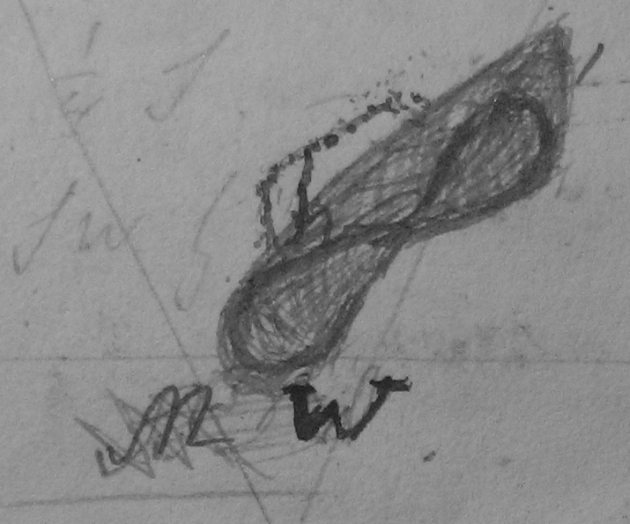
Sunday. —
Granite; porphyritic with Feldspar, crossed by veins of finer grained: decomposing like Bahia: much quartz in veins: little dip or cleavage
— bad observation SW by S. dip. — hills generally rounded often bare flat alluvial valley
[page 2b]
between them. village of Itho-caia. 12 miles from Rio. 3 PM. Temp:
in white sand 104: in shade
View at first leaving Rio sublime, picturesque intense colours blue prevailing tint — large plantations of sugar & rustling coffee:
Mimosa natural veil Forest like but more glorious than those in the engraving; gleams of sunshine: parasitical plants: lianas: large leaves: sun sultry all still. but large & brilliant butterflies: much
[page 3b]
water: surprised to see guinea fowls: our calvacade very quixotic: the banks most teeming with wood & beautiful flowers; village of Itho regular like the Hottentots: the poor blacks thus perhaps try to persuade themselves that they are in the land of their fathers. The rock from which old woman threw herself. —
[page 4b]
Temp of room 86˚ ½
Our dinner: eggs & rice: our host saying we could have anything. —
About 4 oclock & arrived at our sleeping place about 9. — Sand & swampy plains & thickets alternating passed through by a dim moonlight. — the cries of snipes: fire flies & a few noisy frogs goat suckers. Solitary venda1 slept on the table. could get little to eat. —
9.th Mon [April 1832]
1 A poor inn on roads far from town or villages.
[page 5b]
Started about ½ after six. & passed over scorching plains cactuses & other succulent plants (on the decayed & stunted trees beautiful parasitic Orchis with a deliceous smell) glaring hot: therm: in pocket 96˚. — inland brackish lakes with numerous birds. white Egrets —
Herons - whites & cormorants. lost our way
Geology: found a fragment on beach of sandstone with numerous Cardiums Mactra.1 — the whole line of country beach is composed of an extensive
1 A marine bivalve mollusc.
[page 6b]
flat or a lake. between which & sea are large sand hills. on which the surf roars (by night fine effect) fresh land is gaining. — Sand emits a shrill sound
Manatiba [Mandetiba] dined
Temp in shade 84˚
our senses were refreshed by food & a more extended & prettier view: reflection very clear in the lake. —
[page 7b]
These Vendas consist of a house with a shed round it. in which are tables. — a court yard in which the horses are turned into & & sleeping rooms in which straw reeds mats are strewed. —
after dinner passed through a wilderness of lacoons. — some salt in which were Balani others fresh in which
[page 8b]
I caught a small turrited Lymnæa,1 but in this the sea periodically flows perhaps at the SW Gales: is not this fact curious? would not such circumstances produce tertiary2 strata, beds of sand full of Mactra easily cemented: then we went through impenetrable forest. trees [cylc] f very tall. stems
1 Freshwater snail. See specimen not in spirits 138 in Zoology notes, p. 370.
2 The relatively recent period of earth history between the Quaternary (which includes the Ice Age and the present) and the Mesozoic ('Secondary'). Characterised by the dominance of mammals over reptiles and the absence of ammonites.
[page 9b]
white: wonderful beautiful flowering parasites & fire flies, [wren] bird: large ant hills: we have been nearly 10 hours on horseback: slept at Ingetado; after a merry & sleepless night started at 5 oclock: the sky became red & the stars died away & then the planets
(10th) [April 1832]
[page 10b]
all promised well. but 15 miles before arriving at Addea de St Pedro nearly killed us together with waiting an hour for breakfast, the road lay on the borders of lacoon. shore composed of an infinite shells: at ½ after 12 started again; the road passed through sand with broken shells, although
[page 11b]
some miles from the sea. & the trees attested how long things have thus remained: we then entered the forest; beds of quartz boulders; — after some miles came to Campos Novos good venda - in a open country. a pleasant change: very cool on the turf only 74˚. —
[page 12b]
went out collecting (having arrived at 4 o'clock) — & took a frog, & several planorbis.1 Helix2 & Puccinea3
Saw more than 100 buzzards in a flock. —
11th [April 1832]
Passed through several leagues4 of forest. very impervious trees not large: I here first began to feel feverish shivering & sickness. much
exhausted: could eat nothing at one oclock
1 Freshwater snails.
2 A genus of land snail.
3 A small fungus; some rusts and mildews belong to this genus.
4 Distance of about three miles or five kilometres.
[page 13b]
which was the first time I got anything. — travelled till dark: miserably faint & trouble with faintness. —
At night we slept 2 miles S of Marica: felt very ill in the course of day I thought I should have dropt off the horse: horrors of illness in foreign
[page 14b]
country: during the morning C Frio appearing from refraction like inverted tumblers. Gneiss dipping to the South (& then the north). —
(12th). — [April 1832] Started in the morning & doubted whether I could proceed. — Cinnamon & port wine cured me
[page 15b]
in a wonderful manner; passed through more swampy country & then entered a magnificent forest: sublime. trees lofty. well seen & contrasted in the cleared parts: palms, very thin stalks. beautiful in the forest cabbage palm. edible; [spinnach]
[page 16b]
Arrived at the Fazenda of Sosego. situated in a Forest. square. coffee Mandioka.1 much game, number of horses cattle poultry & wild animals: patriarchal style of living a long house. with a roof of reeds.
at one end gay furniture a long dining room & bed rooms kitchen & large store houses: situated on a hillock. on the other side of the
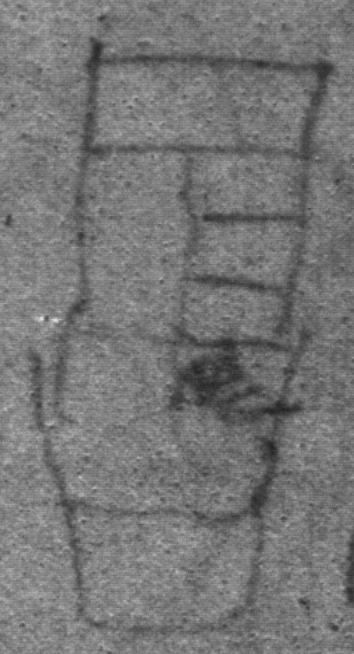 [layout of the fazenda]
[layout of the fazenda]
1 Cassava: the source for tapioca.
[page 17b]
square. sleeping rooms, & round the hill the house of more than one 100 blacks: children of these people stray into dining room. till driven away: daughter of our host Donna Maria, handsome & dignified married to Mr Laurie a scotchman & brother of our companion: on receiving a guest or the Signor a large bell is rung & cannon
[page 18b]
fired. on leaving the house a crowd of blacks come to be blessed by the white man: one morning before daylight I was admiring the stillness of the forest. when it was broken by a Catholic morning raised by a the blacks. effect sublime:
our eating was sumptuous forced to taste everything:
[page 19b]
this patriarchal style fascinating. but destroyed by our host being a villain : enterprising character. has cut excellent roads through the wood: saw mill cutting up thick planks of Rose wood. something like a large-leaved acacia: dreadful the difficulty of procuring surgical aid: our host plenty of Medicines: saw a canoe
[page 20b]
building 70 feet long & 40 more left of solid & thick trunk: I should think in this family the blacks were decidedly happy. — The son in law coming only 2 days short journey found it necessary to bring 17 people with him: stayed at Sosego during the 13th [April 1832]
[page 21b]
On the 14th [April 1832] started at midday for Mr Lennon's estate, after a beautiful ride stopped at a Facend. within a league of our end; blacks miserably worked long after dark: were received very hospitably by the only brazilian that I have yet seen with a pleasant expression
15th [April 1832] Started early saw some beautiful birds, Toucans & bee eaters all the rock is gneiss granite. Mica
[page 22b]
dark coloured large plates: I should think rain had not much degrading effects: valley flat, well seen in the cleared parts;
15 [April 1832]
Started early for Mr Lennon's estate: it is the last cultivated piece till having passed over many miles of country: on our road saw some
[page 23b]
bamboos. disappointed (day before saw a Papyrus?) & some small elegant tree ferns. — had a man to cut a road for us with a sword: when we arrived heard a disagreeable & most violent quarrel — between Mr L & Cowper his agent: they talked of pistols: so bad a character
[page 24b]
that we were cautioned to recollect poison. — Blacks in a bad state; wet cold evening 75˚. — threatened to sell his child as a punishment. yet most certainly a very humane man. —
I observe here & at Socego the clouds rest at a very low level not more than often at
[page 25b]
2 or 300 feet above the & only scarcely any above the adjoining country: Rio Macae is navigable the whole way & not [more] 5 or 6 leagues in length & runs close by these places. — At here the air where passing over the forest on the level of the house becomes converted into cloud: rain has fallen
[page 26b]
every day: a remarkable scarcity of rounded pebbles during all our course in the interior:
16th [April 1832] started early in the morning to the Juer do Paz. & proceeded to Sosego. pleasant ride & much enjoyed the glorious woods: Bamboo 12 inches in circumference. Several sorts of trees ferns:
[page 27b]
17th [April 1832] Sosego. twiners entwining twiners. tresses like hair beautiful lepidoptera.1 silence hosannah. (Frog habits like toad. slow jumps. Iris copper coloured colours become fainter Snake. Cobris de Corrall Fresh water fish. edible Blaps musky shell. stain fingers red one fish from salt Lagoa de Boacica. 2 from brook one do. pricks the fingers
1 Butterflies and moths ('scaly wings').
[page 28b]
Manoel Joaquem da Figuireda after clearing coffee & mandioka is planted. afterwards solely coffee. brother of Manuel has 95000 trees, producing 2 lb per tree (some produce 8 lb) rice on the swampy parts & some sugar cane 3 bags of rice produced
[page 29b]
320. —
Teijõa beans are cultivated. one bag bringing sometimes 80 bags:
Mandioka stems & leaves eat by cattle. roots are ground. a slave holding them against the wheel. the pulp is then pressed dry & baken: excellent eating. —
March is the great season for planting. —
[page 30b]
the juice thus procured from the root is deadly poison: but the animals very fond of it. always dye: — from this Tapioka the made:
18th [April 1832]
Socego. mimosa exquisite foliage & ferns ditto. — trees average 3-4 feet circum in the bole. A creeper circum. 1 ft '' 4
[page 31b]
spent the whole morning in thus rambling in the forests. sublime devotion the prevalent feeling: this days delay was owing to Mr Lennon going to visit his estate with Mr Cooper
19th [April 1832] Left Socego & slept at Venda de Matto: took a most glorious walk on the beach high & magnificent surf. —
[page 32b]
20th. [April 1832] returned by the old route to Compos Novos. a tiresome ride all through a scorching & heavy sand. plain of rhododendrons had some difficulty in making our horses swim & in danger from a drunken man in canoe. — 21st [April 1832] time often by S † [Southern Cross] Started by daylight arrived after
[page 33b]
a very long day almost without rest to Rio Comboata: miserable venda. — passed through an interesting cultivated country: this is the interior road, branching off at Paratra; Many of the fields from numbers of ants nest looked like Humboldt mud volcanoes
[page 34b]
22nd [April 1832] from our sleeping place to Fresqueria de Taboraa, torrents of rain during the whole day. destroying pleasure of a pleasant country: breakfasted at Madre de Dios. a nice village: on road beautiful & flowers passifloras & many birds: soil resulting from decomposing gneiss — generally
[page 35b]
reddish clay producing sugar cane. little coffee: met several riding people & a few heavy carts dragged by 8 oxen. wheells almost a solid board. — no house in the whole country as good as a good farmers house. no road as good as a bad turnpike road in its worst parts. —
[page 36b]
at the vendas seldom see a woman. not worth seeing distances most inaccurately known. — not above a score of murders or crosses. — In Heavens name in what are blacks better off than our English labourers? The national guardsman
[page 37b]
is often a wretched looking mulatto with a sword strapped to his side.
— Th. cold 62 ½ at Compos a supper of fowls & rice & biscuit & bottle of good wine, & coffee in evening & morning with fish in the morning
Indian corn & grass for our 3 selves & horses for 3 Mill reys1 alltogether MR = 2s 6d. —
1 The local currency in Brazil.
[page 38b]
Acacia 23rd [April 1832] Home a very pleasant day [through] a much more [cultivated] & pleasant.— some few pretty villages. Praia grande plagued about our horses not having a passport
24th [April 1832] Wednesd Tuesday — Staid on Board. I found a days rest so delightful. — they have turned the poop
[page 39b]
Cabin into eating room — change of officers. — riots in the town
Thursday 25 [April 1832] Wednesday took my things to Botofogo shipwreck
26th [April 1832] Friday Thursday engaged in drying my things
27th [April 1832] Saturday Friday Worked my interior Bahia collection. went to Mr Astons1 pleasant like
1 Arthur Ingram Aston (1798-1859), Secretary of Legation at Rio de Janeiro 1826-33.
[page 40b]
Cambridge. not the Ambassador. —
28th [April 1832] Breakfasted with on board met Captains Talbot1 & Hardy: Called on the Admiral2 dined there pleasant evening. very gentlemanly the officers. —
29 [April 1832] Sunday quiet delightful day at Botofogo writing journal
1 Charles Talbot (b. 1801), commanded HMS Warspite, 1830-42, who rescued the Brazilian Royal Family from an insurrection on 6 April 1831.
2 Thomas Baker (d. 1845) Admiral, commanding the South American station, 1829-33. The South American station was the operational base for the Royal Navy in the seas around that continent.
[page 41b]
30th [April 1832] — Dined at Mr Astons.
31st [1 May 1832] — Worked at fresh water animals
16th [June 1832]. —
Tijeuka. — country much furrowed by water. enormous blocks. — chiefly a compact mica slate. — & quantities of trap. —
scenery always beautiful
Temp [of 2 W] 66˚
Chain of [hills] NE & SW
[page 42b]
Palm [nearly] 9 ft at top circum. 2 ⅔ at bottom 3 ⅓ — — 305 rings
184
131
59
90 (850)
Myrmecia1 in corner of leaf Ctenus2 in trees. — Spiders certainly see far —
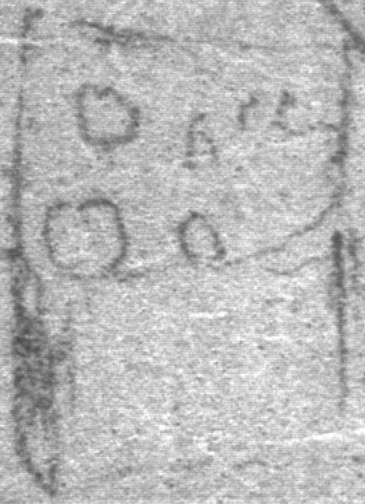
180
24
—
720
360.
—
4720
32
—
795
180
25
—
900
3600
4500
36
—
(77.)
1 An ant-mimicking spider, see Zoology notes, p. 46.
2 Hunting spiders that do not spin webs. See Zoology notes, pp. 51-2.
[page 43b]

[sketch of a fragment of gneiss embedded in another variety of the same rock at Botofogo Bay (fig. 22, p. 143 in South America) over which appear to be two figures]
ESE & WNW joining distinct cleavage nearly same direction 7 yard long NNE dip vertical coated by gneiss plates [illeg] two broad 2 wide
[page 44b]
Epeira pass through the web — —
Marvellous power of motion. generally full in aloes. knew the diff of my finger & stick?
small ones.
centra mat-work
[page 45b]
cleavage NE. (41 ∠) siliceous1 mica slate
dyke N ½ W . —
dyke of generally fine grained trap. much decomposed. angular lines of cleavage — decomposing into balls
in places becoming [slightly] serpentine2 in
1 Containing abundant silica (i.e. silicon dioxide) or quartz. Silicates are the most abundant rock-forming minerals in the Earth's crust.
2 A mineral derived from olivine.
[page 46b]
balls very tough X X
then another rock (& vein [partly]) with small veins [intangled] into mica slate.
Dyke at least 100 yards long & 20 wide
[Mica] 22 of iron
[page 47b]
5th [July 1832] Sailed
6th [July 1832]— Calm in sight of Sugar Loaf
7, 8th [July 1832] Very sick. not so bad Cape pidgeons whales
9 [July 1832] but little better.
Rio Corcovado.— (Bones). [illeg]
[page 48b]
(14th) [July 1832]
¼ 11 oclock PM
Cumili
Fresh Breeze N Sky pale blue
few minutes duration (Fine night)
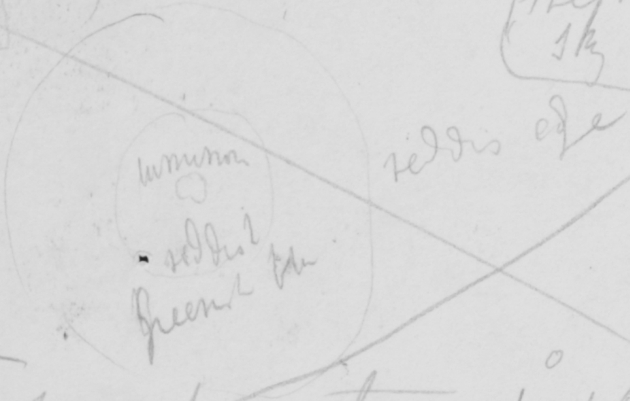
[sketch of aureole around moon]
reddish edge luminous reddish greenish blue whole red diameter, 1˚ 45'
Whole diameter about double clouds passing larger colour indistinct ring. —
[page 49b]
14th [July 1832] Fine day & prosperous breeze.
Sunday 15 [July 1832] 160 miles since noon of yesterday; Grampus: uncertain weather gale: Morro de St. Martha: top gallant yards:
16th [July 1832] much sea sick
Snake burrowing in the ground.
Pompilus1
68 ½. 61 ½
59
1 Specimen 534 in Darwin's insects, p. 56.
[page 50b]
Barrell with spirits
Bottles —
[pincer] — for insects & bottle
Pix axe
Buck shot
18th [July 1832]
Lat. 31˚ 37 S
6 14 W
6˚ 18 W
43 8 Long 49˚ 22 W
Flying fish. Porpoises
[page 51b]
E by North — mice slate. — chloritic1 schist.2
1 Containing conspicuous amounts of the mineral chlorite.
2 A metamorphic rock intermediate between slate and gneiss
[page 52b]
M Video
1'. spider tube in rock long. 1 & ½ inch long bag shaped
ESE — slate (chloritic) or 5 yards thick alternating with mica slate. (between Rat Island & Mount strike various ESE E by N
+ chloritic slate cleavage running ESE. vertical
smooth line of cleavage fracture running at ∠ and
[page 53b]
dipping to E 20˚
on the Mount — slate with crystals passes into trap. sonorous1 (+ +)
running E by N & in the line of Rat Island R Island
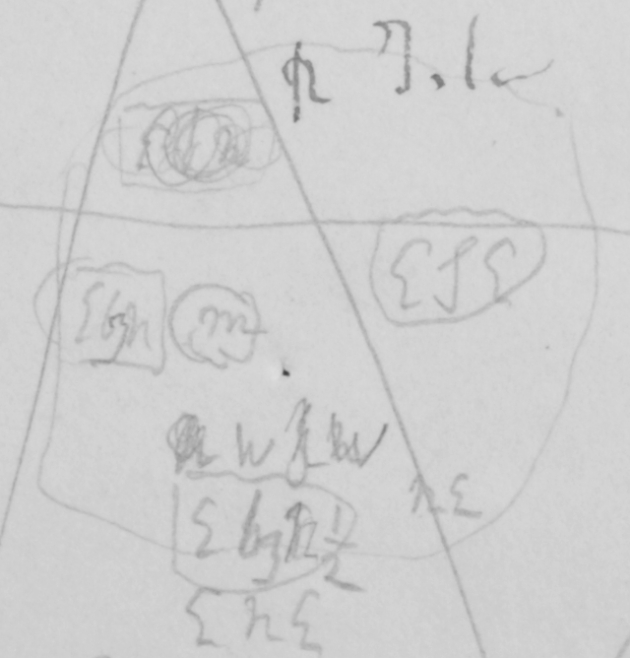 [The Mount at Monte Video]
[The Mount at Monte Video]
[illeg] by N E by N M ESE WSW E by N ½ NE ENE
quartzone mica slate & again slate chloritic
1 Makes a ringing sound when struck.
[page 54b]
A. Hornblendic slate same site as last
(a point further on behind hill B paps of compact mica slate containing feldspar much fe quartz vein of Quartz
(Hyalomictite)1
1 A glassy volcanic rock.
[page 55b]
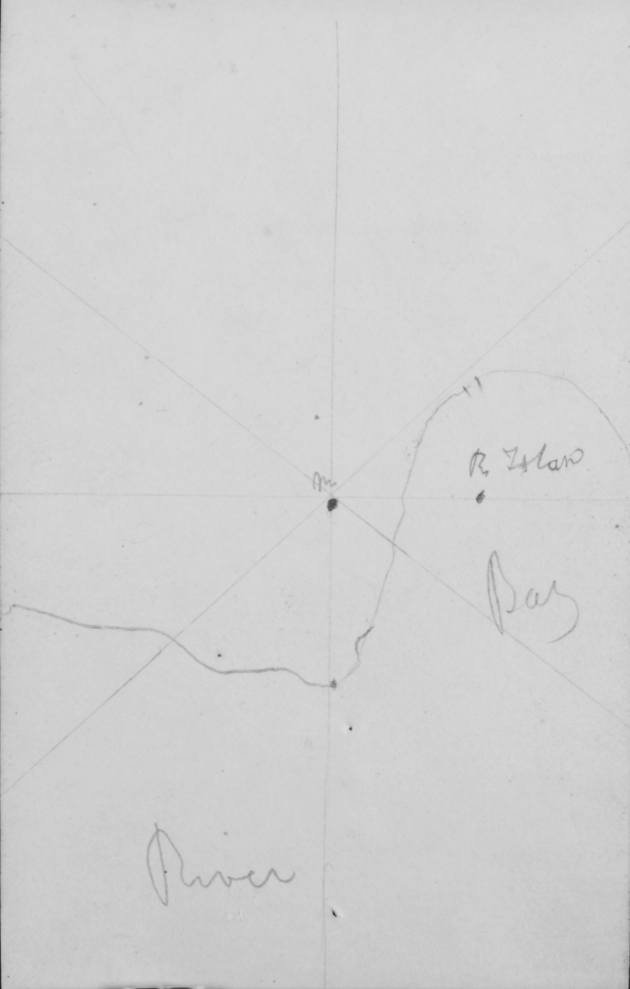
[Survey map of Monte Video. See the survey map of 'Harbor of Monte Video Rat Isl.d' in DAR32.83A. This and the following sketch are unique in the field notebooks because a ruler was used.]
River
M Bay
R. Island
[page 56b]
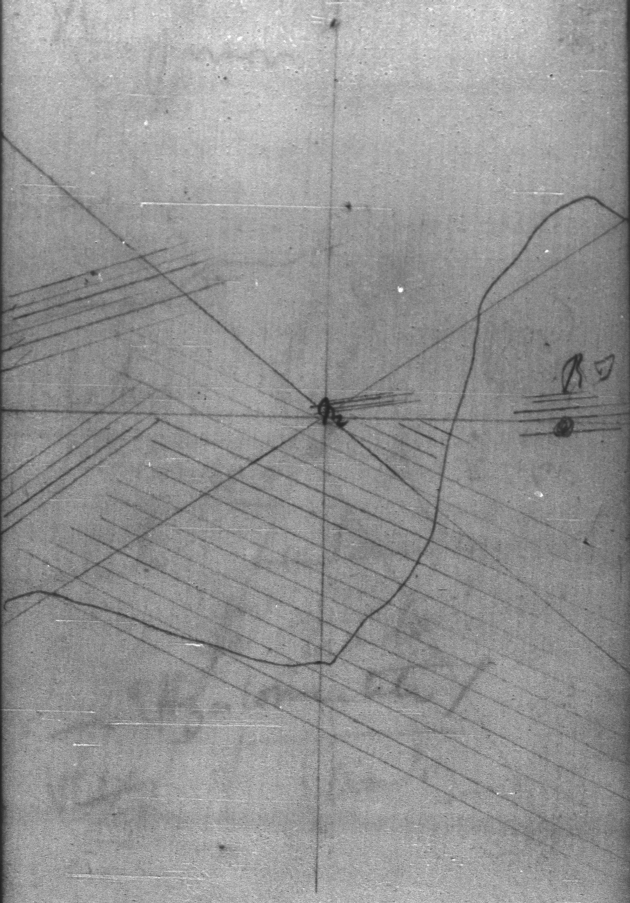
[larger scale survey map of Monte Video showing orientation of cleavage]
R I
[page 57b]
Mica slate. (fracture plains) dipping about ESE. at ∠ 12˚
Chloritic slate (vide supra) entangled in mica slate & every where penetrated by curved veins of granitic crystalline quartz see specimen —
[page 58b]
in second or small piece of chloritic schist entangled: line of cleavage & fracture same as mica slate
planes of fracture even dipping SSW
Salt springs streams & bed of muscle shells under town show recent origin.
[page 59b]
August 15th [1832]
Chloritic E & W (G E by S
Mica slate intangled with quartz veins (G E by N ) (cleavage vertical)
alternation ESE (G: E by N)
(G NE by E) compact slate specimen (A).—
(G) NE cleavage NE by E?
do (G NNE)
all these was been near the coast
[page 60b]
near summit — (B)
(G NNE) chloritic compact slate cleaving E by N
do (G NE by E)
(G E ½ S) cleav. E by N ½ N. slate
(G W NN) clear E by N D slate
pushed over & contorted
[page 61b]
right through centre of hill E by N [this] compact D sonorous slate conchoidal fracture1
(G SSE) clear ENE cleavage has a tendency to lean over & dip to NNW — on other side it leans or dips to opposite quarter of the compass
1 The way brittle materials such as glass fracture, not following any natural planes of separation.
[page 62b]
Capincha1
Girth 3' 2
length 3. 8 ½
Shoulder to toes 1" 9
weight 98 pounds
Linnaeus — Planaria2
Sept 22d [1832] —
Entrance of creek. dark blue sandy clay much stratified dipping to NNW or N by W at about 6˚ ∠: —
1 The capybara, the world's largest rodent. See Zoology notes, p. 67; listed in Mammalia, p. 91 as Hydrochœrus capybara.
2 A genus of flatworm (Platyhelminthes). See Zoology notes, p. 66 and p. 67 note 1. Darwin 1844 published some descriptions of the specimens he collected; Shorter publications, pp. 179-87.
[page 63b]
on the beach a succession of thin strata dipping at 15˚ to W by S. & conglomerate quartz & jasper1 pebbles with shells — vide specimens. —
On the coast about 12 feet high—
Proceeding to the
1 An amorphous silica.
[page 64b]
in the conglom: teeth & thigh bone Proceeding to the NW. — there is a horizontal bed of earth, containing much fewer shells, but armadillo
— this is horizontal but widens as gradually. hence
[page 65b]
I think conglomerate with broken shells was deposited by the action of tides earth quietly
Is this above the clay which is seen a short way time previously?
Covered by diluvium & sand hillocks
[page 66b]
as earthy bank thickened & cropped out in direction NNW it probably overlies the clay. —
[sketch?]
[page 67b]
October 2d [1832]1 [50] feet high horizontal sand with pebbles
do
main bed of red earth:
lower parts containing limestone2 in nodules & layers
1 There is a gap in the notebook between 23 September to 1 October 1832.
2 A sedimentary rock composed mainly of calcium carbonate, usually of biological origin (e.g. from corals).
[page 68b]
or indurated marle1
(1)
lower parts redder — all very compact
Vertebra of 2 animals
+ + [caught] by the tide
14. feet red earth with layers of calcareous, about 12 of yellowish
1 Lime-rich clay.
[page 69b]
softer earth. —
6 inches of indurated sandstone. blacker
20 feet of wavy sands indu cemented.
In NW by W section on coast — lower beds crop out & thicken:
[page 70b]
Punta Alta. Octob 6th [1832]
The beds have been deposited in the sea. hence inequalities in the lower conglom is filled up by the Tosca & then again by the upper bed which is sometimes conglom & sometimes earthy.
circumstances were rather different during its deposit & present though: the
[page 71b]
sea is now destroying it & has destroyed a bank of some miles leaving only lower horizontal conglom: whilst on other places it is now heaping up bank. — believed the cliffs in a bit of table land formerly bottom of sea — & the line of heaped
[page 72b]
up bank & on this is nearly continuous with the rest of coast. which show there was not such very great dissimilarity of circumstances: subsequent to the general elevation the strata have been washed away but that now the sea has begun again to heap
[page 73b]
them up:
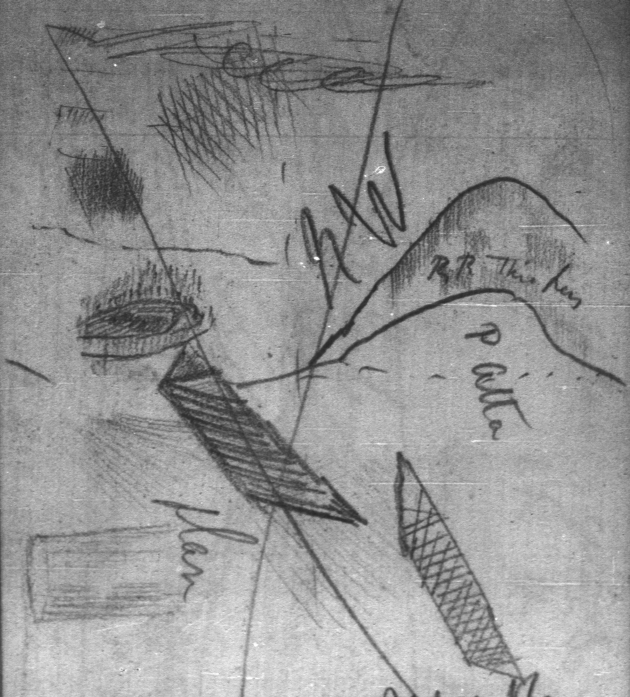
[map and section of Punta Alta]
NW RR Thickness P Alta plan
red earth resembles that at Mt. Hermoso
[page 74b]
section
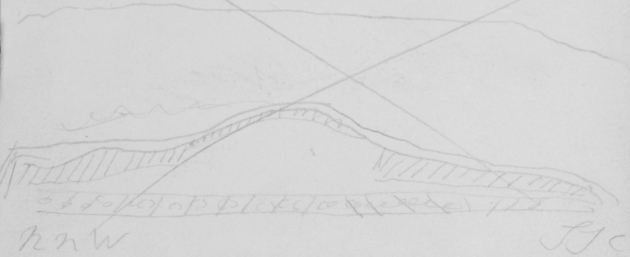
[section of Punta Alta]
NNW SSE
[page 75b]
All the conglom contains quartz & fine sandstone pebbles like the Rio Negro tides flow from the south

[section of Punta Alta]
detritus red earth gravel red earth lower gravel argillaceous or marly thin beds
[page 76b]
Look for Azzarras book
Edge of formation NNW, SSE.
Having dug three feet deep, it consisted of the same hard earthy matter as cliff. there was a fragment of Ostrea. — The upper foot was stained black
[page 77b]
by the vegetation I think it clear this belongs to the Punta Alta & M. Hermoso formation: but that from some cause neither sandstone nor conglom were deposited; perhaps this was further t plain turf level — probably caused
[page 78b]
by sudden irruption of earthy matter from the shore —
The sea probably flowed over it for some time as sand hillocks show: sand hillocks running W by N. E by S.
(K 2 ) bearing to tent WSW ½ W bearing to
[page 79b]
the line in which hole was dug.
ship was thus 
(K) O [sketch map of Punta Alta showing ship, the Beagle]
The pumice1 pebbles are most remarkable lying in numbers on the surface. — were they left when the Tosca was
1 Solidified frothy lava, generally lighter than water.
[page 80b]
deposited or by a subsequent inundation probably contempraneous with detritus on Punta Alta —
Lava Pumice pebble[s] probably washed up with the banks at first deposit: sand
[page 81b]
hillock not connected between . anchor chain & P. Alta
Tosca
Upper detritus or diluvium deposited in water on account of pebbles shells quartz sandstone greenstone marly limestone & pumice. Hills of do. probably formed when Megatherium1 like armadillo case
[written across or under other entries:] Plants like heath Salt places.
1 The extinct giant ground sloth (meaning 'big beast').
[page 82b]
was lifted up: Tosca & upper gravel pass into each other. Tosca contains smaller pebbles & bits of shells:
Sand hill behind the plain strikes to the coast. from the [Alta] on each side
[page 83b]
2 small chain run. the one by the creek perhaps partly modern: within of this [side] the Tosca plain bounded by N & S Line extends Tosca has been denuded: gravel beneath extends horizontal: — Parrot eggs
Hence Detritus is diluvium / green Phonolite
[page 84b]
Examine diluvium; are there any lava pumice pebbles: Are there shells in Tosca: Has the deposit of sandstone cut up the Tosca; examine action of tide on the latter: Are there old shells on hillocks: examine general appearance of latter: Is the Tosca externally harder; (no)
(Lava pebbles) siliceous sandstone & the sandstone broken up by
quartz pebbles.
Swifts in flocks.
Curious habits of Lizard
NNW by W line in which the strata thicker —
remarkable gradual shoal to the anchor:
(5 to 7) 2 miles black clay formed by the action of water on the Tosca
[page 85b]
Phylla Mica Slate with straigh[t] bands of siliceous when most frequent is altered into Phyllade1 — — frequent alternation — crossed by irregular beds or dykes of (granitic?) rock
which runs into it the quartz[oze] bands, only differs in not
1 A finely-splitting metamorphic rock, generally intermediate between slate and schist.
[page 86b]
possessing cleavage ∴ — if mica slate was deposited in horizont layer this must have been a piece in middle projecting upward [without] any—
Rowlett1 about trousers
Sea eggs2 50 fathoms off the Straight of Magellan
1 George Rowlett (d. 1834), Purser of the Beagle.
2 Sea urchins.
Textual notes to the Rio notebook
[FC] a faint word or number in pencil is now illegible.
[IFC] 1.10.] Down House number, not transcribed.
88202330] English Heritage number, not transcribed.
[IBC] C. Darwin] ink.
1A] added by Nora Barlow, pencil, not transcribed.
[1b] NW] ink, obscured by doodle in ink.
[11b] Campos Novos] added pencil.
[48b] page written parallel to the spine.
[53b] R Island] ink.
[54b] Hyalomictite)] ink.
[81b] Megatherium...places.] written perpendicular to the spine over 'Upper'.
[The Beagle field notebook identifiers were re-set in January 2021 meaning the page counters were reset to 0. At that time this notebook had 18638 visits.]
 REVISION HISTORY: Scanned by Historic England. Transcribed from microfilm by Gordon Chancellor; transcription typed and checked against microfilm by Kees Rookmaaker, 6.2006. Corrected by Chancellor 7.2006. Further editing and corrections by John van Wyhe 9.2006, checked against the manuscript by van Wyhe 5.2007. Transcription revised and edited by van Wyhe 6-12.2008. RN15
REVISION HISTORY: Scanned by Historic England. Transcribed from microfilm by Gordon Chancellor; transcription typed and checked against microfilm by Kees Rookmaaker, 6.2006. Corrected by Chancellor 7.2006. Further editing and corrections by John van Wyhe 9.2006, checked against the manuscript by van Wyhe 5.2007. Transcription revised and edited by van Wyhe 6-12.2008. RN15



 [layout of the fazenda]
[layout of the fazenda] 


 [The Mount at Monte Video]
[The Mount at Monte Video]




